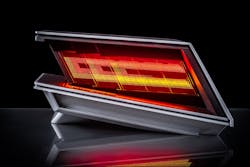Ams Osram, which once had OLEDs in mind for automotive applications such as tail lights, is now approaching the same sector with an alternative thinning and bending technology for mini LEDs.
The Premstaetten, Austria–based company announced at the International Symposium on Automotive Lighting (ISAL) in Darmstadt, Germany that it is mounting mini LEDs on a transparent foil substrate to make its new Aliyos product for automotive exteriors and interiors.
The thin “LED on foil” technology supports innovative rear light functionality, such as displaying symbols, words, or images that can convey warning information to other motorists or that can distinguish a car and a brand with a decorative or unique look, ams Osram said.
It’s the same sort of advantage that OLED companies like Rochester, New York–based OLEDWorks are offering. For example, OLEDWorks provides OLED-based tail lights to German car maker Audi for use in some models.
Prior to its acquisition by ams, Osram had been developing OLED-based technology for Audi. But OLEDWorks has taken over in that area. Ams Osram is instead focusing its efforts on mini LEDs, which are smaller than standard LEDs but larger than the micro LEDs that represent a good chunk of ams Osram’s future revenue plans.
OLEDs are thin patches of material that light up in response to a current. Purveyors such as OLEDWorks say they are the ultimate in thin light sources and in bendability, and are thus well suited for design into automobiles and elsewhere. LEDs are singe points of light from a chip.
One big challenge for OLED manufacturers is that LED makers continue to find ways to design LEDs into thin and flexible formats, such as the new ams Osram Aliyos.
Ams Osram said that it is working with “Tier One suppliers and OEMs to explore the new possibilities in automotive interior and exterior lighting.” It did not reveal the names of the partners.
The company noted that the technology can create 3D and animation effects when multiple foils are placed one behind the other.
“One demonstration design exploits the transparency of the Aliyos foil substrate to produce new 3D effects in rear lights: a transparent array of three Aliyos LED foils mounted one behind the other creates a sense of depth,” the company said. “Another design shows that Aliyos LED-on-foil technology can be applied to curved body panels, and is invisible when turned off, creating the effect of ‘light out of nowhere’.
Ams Osram said it aims through its partners to equip cars with Aliyos technology by the end of 2025.
MARK HALPER is a contributing editor for LEDs Magazine, and an energy, technology, and business journalist ([email protected]).
Follow our LinkedIn page for our latest news updates, contributed articles, and commentary, and our Facebook page for events announcements and more. You can also find us on the X platform.





